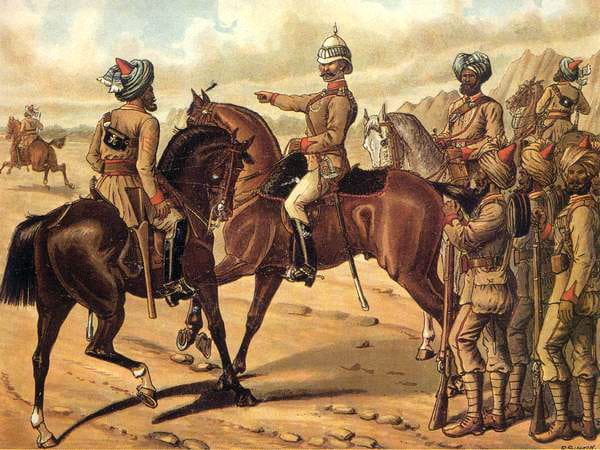khaki

Khaki is a light brown or tan cloth, usually of cotton or wool, or simply a designation of that color. In past decades it was associated with military uniforms but has become less so of late. This word, like many others, is a legacy of British colonialism. The word is borrowed from the Urdu khaki, meaning dusty, which has a root of khak, dust. And it was British troops occupying India that first adopted khaki uniforms.
The first “British” soldiers to do so were the Corps of Guides, a regiment of Indian soldiers, with British and Indian officers, formed in 1846. Secondary sources claim the Guides were nicknamed the Old Khakis prior to the Indian Insurrection of 1857, but I have not found any primary sources with that usage. For instance, there is this in a biography of General Harry Burnett Lumsden, who commanded the Guides, written by his younger brother Peter, who also served in India. But while this is in reference to the period around 1850, the passage was not written until 1899:
There used to be a good deal of rivalry between the Guides and the 1st Punjab Rifles in border expeditions. While the former were styled “Khákis” from their dust-coloured clothing, the latter went by the name of the “Siah posh”* owing to their being clothed in invisible green, like British Rifle Corps.
The note for Siah posh reads, “Black-coated.”
Other British regiments in India began to dye their uniforms khaki during the insurrection. We see this adoption of khaki uniforms by British soldiers in a letter written by Herbert Benjamin Edwardes to Harry Lumsden from Peshawar during the insurrection:
The whole of the troops here are dressed in khâkee.
There is a reference to Khakee Infantry in the London newspaper The People of 5 September 1857:
The 52nd and Khakee Infantry supported us as well, but the heat and long marches knocked the 52nd up very much.
The 52nd regiment was one that had adopted khaki uniforms during the insurrection, so it’s unclear exactly what the Khakee Infantry refers to here. It may have been the Guides or other British and Indian troops, perhaps inclusive of the 52nd, who had adopted khaki uniforms.
And we see a direct reference to khaki uniforms from 2 January 1858, again reported in The People:
We then rode to the artillery end of cantonments; in the artillery barracks we found four companies of Highlanders just arrived; actual Highlanders, the gallant 93rd, with broad shoulders, thick bare calves, actual tartan kilts, and very long, very loose open khakee jackets with red cuffs and collars.
Khaki was much better suited to the modern battlefield than the brightly colored uniforms of centuries past, and by the close of the nineteenth century, khaki had become the standard uniform of the British army so much so, that in the election of 1900, during the Boer War, the phrase to vote khaki became a catchphrase meaning to support the government and the war.
The US Army adopted khaki as a hot-weather uniform during the Spanish-American War of 1898 and phased it out from its uniforms in the early 1980s.
And today, khaki-colored trousers have lost most of their military association but have become an office-casual “uniform.”
Sources:
Edwardes, Herbert Benjamin. Letter to Harry Burnett Lumsden, 21 July 1857. In Peter S. Lumsden and George R. Elsmie. Lumsden of the Guides. London: John Murray: 1899, 200. HathiTrust Digital Library.
“The Indian Revolt. The Relief of Lucknow.” People (London), 2 January 1858, 5/6. Gale Primary Sources: Nineteenth Century Collections Online.
“The Indian Revolt. The Siege of Delhi.” People (London), 5 September 1857, 5/6. Gale Primary Sources: Nineteenth Century Collections Online.
Oxford English Dictionary Online, 1901, s.v. khaki, adj. and n.
Whitehorne, A. C. “Khaki and Service Dress.” Journal of the Society for Army Historical Research, 15.59, Autumn 1936, 180–83. JSTOR.
Image credit: Richard Simkin, 1891. Wikimedia Commons. Public domain image.